

Wir sind miteinander verknüpft
mailto: payer@hdm-stuttgart.de
Zitierweise / cite as:
Entwicklungsländerstudien / hrsg. von Margarete Payer. -- Teil I: Grundgegebenheiten. -- Kapitel 8: Tierische Produktion. -- 9. Seidenraupen / zusammengestellt von Alois Payer. -- 2. Teil II. -- Fassung vom 2018-10-08. -- URL: http://www.payer.de/entwicklung/entw0892.htm. -- [Stichwort].
Erstmals publiziert: 2000-07-20
Überarbeitungen: 2018-10-08 [grundlegend überarbeitet] ; 2001-02-21 [Update]
Anlass: Lehrveranstaltung "Einführung in Entwicklungsländerstudien". HBI Stuttgart, 1998/99
©opyright: Dieser Text steht der Allgemeinheit zur Verfügung. Eine Verwertung in Publikationen, die über übliche Zitate hinausgeht, bedarf der ausdrücklichen Genehmigung der Herausgeberin.
Dieser Text ist Bestandteil der Abteilung Entwicklungsländer von Tüpfli's Global Village Library.
Skript, das von den Teilnehmern am Wahlpflichtfach "Entwicklungsländerstudien" an der HBI Stuttgart erarbeitet wird,
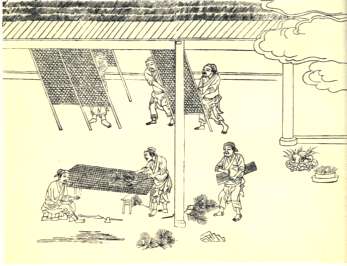
Abb.: Das Aufsetzen der Spinnbretter, die aus gebündelten Reisstrohhalmen
bestehen
| Lebenstag | Durchzuführende Arbeiten |
|---|---|
| 34. | Raupen werden spinnreif. Spinnrahmen (Holz, Reisig, Stroh) vorsichtig auf Hürden aufsetzen. Nur so viele Blätter auflegen wie tatsächlich gefressen werden. Die bereits mit Einspinnen beschäftigten Raupen keinesfalls stören. Erschütterungen, Lärm, direktes Licht und Staub vermeiden |
| 35. | Fast alle Raupen befinden sich zum Einspinnen im Spinnrahmen. Noch umherkriechend Raupen auf Spinnrahmen setzen |
| 42. | Raupen, die noch nicht mit Einspinnen begonnen haben, werden abgelesen und auf besondere Hürden gesetzt |
|
|
|
| 45. | 10 Tage nach Beginn des Einspinnens sind die Kokons reif. Sie werden vorsichtig entfernt, ausgelesen und zum Abtrocknen luftig gelagert |
[Vorlage der Tabelle: Seidenbau-Ratgeber / Hrsg. Fritz Hofmann ; Ursula Hense. -- Radebaul [u.a.] : Neumann, 1951. -- Zitiert von Legel, Siegfried. -- In: Nutztiere der Tropen und Subtropen / Hrsg. Siegfried Legel. -- Stuttgart [u.a.] : Hirzel.. -- Bd. 3: Pferde/Esel, Schweine, Elefanten, Geflügel, Bienen, Seidenspinner. -- ©1993. -- ISBN 3777604976. -- S. 710f. ]
A straw frame is placed on the tray and the silkworm starts to spin the cocoon by moving its head in a figure eight.
Abb.: Seidenraupe beginnt sich einzuspinnen, Südafrika (©Corbis)The silkworm produces silk in two glands and forces the liquuid silk through openings, spinnerets, in its head.
Abb.: Aufbau des SeidendoppelfadensThe two strands of silk are coated with a water-soluble protective gum, sericin. When the silk comes in contact with the air, it solidifies. In 2 or 3 days, the silkworm has spun approximately 1 mile of filament and has completely surroundet itself in a cocoon." [Kadolph-Langford, S. 62]
Thailand: "At this stage they are moved to large, circular, compartmentalised trays, called jaw, which are about 5 ft (1.5 m) in diameter. The ripe worms attach themselves to the wall of a compartment by secreting a small droplet of gum. First the preliminary web, called floss, is spun, and this forms the foundation for the main filament. The whole process takes two to three days." [Conway, S. 66]
Abb.: Puppe in aufgeschnittenem Kokon [Quelle: Brockhaus, 1895]
Abb.: Puppe in aufgeschnittenem Kokon, Mysore, Indien, 1990 (©Corbis)
|
|
|
|
|
|
Thailand: "When spinning stops, the cocoons are removed from the jaw, and stored in a basket covered with a cloth to prevent insect infestation. The cocoons must be reeled within ten days or the moths hatch and damage the silk filaments. Any cocoons which are damaged or infested are rejected before reelingy begins, and some healthy cocoons are held back and allowed to hatch into moths to continue the breeding cycle." [Conway, S. 66]
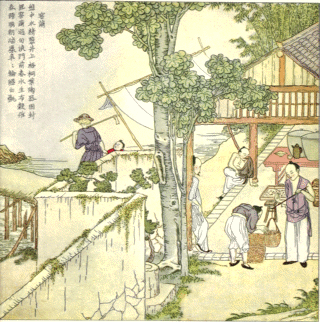
Abb.: Das Verwahren der Kokons in tiefen kühlen Töpfen: durch die Kälte wird
die Entwicklung zum Schmetterling verlangsamt
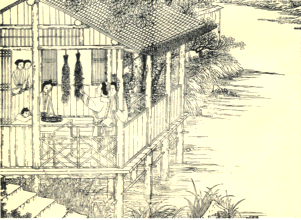
Abb.: Aus einigen Kokons werden Schmetterlinge entwickelt, um aus ihrer Paarung
neue Eier zu gewinnen
"If the silkworm is allowed to reach the moth stage, it is used for breeding additional silkworms. The moth secrets a fluid that dissolves the silk at one end of the cocoon so that it can crawl out.
Abb.: Kokons mit geschlüpften Maulbeerspinnern, Mysore, Indien, 1989 (©Corbis)Cocoons from which the moths have emerged cannot be used for filament silk yarns and the staple silk from these cocoon is less valuable." [Kadolph-Langford, S. 62]
"Entsprechend der Aufgabenstellung, entweder die Erzeugung von Eiern reiner Rassen oder von Eiern durch Kreuzungen, werden die ausgewählten Kokons auf Rahmen oder Zuchthürden ausgebreitet oder aufgebracht.
Einfach gestaltet sich das Auflegen der Kokons bei reinen Rassen. Die geschlüpften Falter werden nach erfolgter Kopulation abgelesen und eingetütet oder in spezielle Zellen gebracht. Tüten oder Zellen sind entsprechend gekennzeichnet.
Für die gegenwärtig übliche Kreuzungs-Hybridzucht -- unter Verwendung europäischer und asiatischer Rassen -- ist es notwendig, zwei reine Rassen aufzuziehen. Die Kokons der beiden zu verpaarenden Rassen müssen vor dem Schlupf getrennt werden. Für die Trennung der Geschlechter gibt es zwei Möglichkeiten:
- Männchen und Weibchen werden kurz nach dem Schlupf noch vor der Paarung abgelesen und getrennt in entsprechende Behälter gegeben. Die Männchen erkennt man am heftigen Flügelschlagen gleich nach dem Schlupf. Weibchen bleiben neben dem Kokon sitzen. Die Geschlechtertrennung kann durch Kokonsortiermaschinen wesentlich erleichtert werden. Dabei wird die Tatsache genutzt, dass weibliche Konkons größer als männliche sind. So kann man von der einen Rasse vorwiegend Weibchen, von der anderen vorwiegend Männchen schlüpfen lassen. Eine völlige Trennung ist jedoch auch bei dieser Methode nicht möglich, so dass sie nur für Massenkopulation verwendbar ist.
- Bei gezielten Paarungen werden die Kokons vor dem Schlupf in gekennzeichneten Einzelbehältern (Isolatoren) untergebracht."
[Legel, Siegfried. -- In: Nutztiere der Tropen und Subtropen / Hrsg. Siegfried Legel. -- Stuttgart [u.a.] : Hirzel.. -- Bd. 3: Pferde/Esel, Schweine, Elefanten, Geflügel, Bienen, Seidenspinner. -- ©1993. -- ISBN 3777604976. -- S. 696]
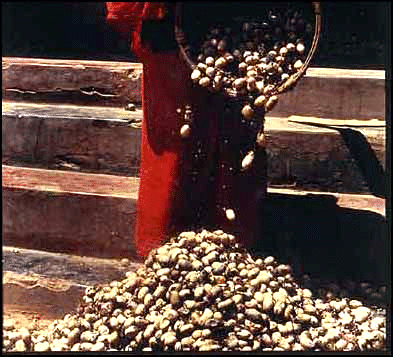
Abb.: In Indien werden Kokons manchmal an der Sonne getrocknet und
die Raupen so abgetötet:
[Quelle der Abb.: http://www.jjexporters.com/images/proc1.jpg. -- Zugriff am 2001-02-21]
Die Verarbeitungswege vom Kokon bis zum Seidengewebe zeigt folgendes Schema:
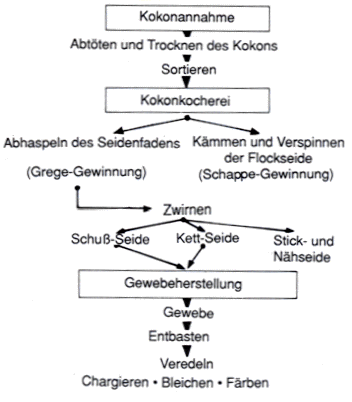
Abb.: Verarbeitungswege vom Kokon bis zum fertigen Seidengewebe
[Quelle der Abb.: [Legel, Siegfried. -- In: Nutztiere der Tropen und Subtropen / Hrsg. Siegfried Legel. -- Stuttgart [u.a.] : Hirzel.. -- Bd. 3: Pferde/Esel, Schweine, Elefanten, Geflügel, Bienen, Seidenspinner. -- ©1993. -- ISBN 3777604976. -- S. 713]
"The silkworm then begins to change into a chrysalis and then into a moth. Usualy the silkworm is killed (stifled) with heat before it reaches the moth stage. ...
Sortieren der Kokons
Abb.: Das Sortieren der Kokons
Abb.: Sortieren von Kokons, Ranaketugama, Sri Lanka, 1993 (Quelle: FAO)To obtain filament silk from the cocoon after stifling, the cocoons are sorted for fiber size, fiber quality and defects, then brushed to find the ouside ends of the filaments. Several filaments are gathered together and wounded unto a reel. This process, referred to as reeling, is performed in a manufacturing plant called a filature." [Kadolph-Langford, S. 62]
Thailand: "When there is a good supply of cocoons ready for reeling, a small charcoal or wood fire is prepared. Some women prefer a log fire because they say it is easier to control the heat. A clay pot or metal cauldron of water containing silk cocoons is placed over the fire and the water temperature kept just below boiling-point.
Abb.: Kochen der Kokons, Chiangmai, Thailand (©Corbis)
Abb.: Gekochte Kokons, fertig zum Abhaspeln, Chonabot, Thailand, 1989 (©Corbis)Hot water releases the silk filaments which are drawn up through a forked bamboo batten from between ten and twenty cocoons at a time and twisted to form a single silk strand. The strand then passes over a conducting reel and on to a bamboo spool or is reeled into a basket. An experienced silk reeler can tell if the denier alters by the feel of the thread as it passes through her fingers. If the denier feels thinner she will automatically attach additional filaments. Hand-reeled silk is rounded in texture and has a distinctive sheen which is important to the character of Thai silk. The roundness and regularity of the ply assure that the silk will dye to an even colour.
Reeling silk is a laborious process, taking approximately twelve hours to reel 0.5 lb (0.25 kg), and the women often sit in groups to chat while they work. Silk is reeled into three grades.
Filaments from the outer layer of the cocoon are relatively coarse and hairy and are skeined separately. Nowadays they are sold to outside buyers for weaving into soft furnishing fabrics.
Filaments from the middle layer of the cocoon are the smoothest and easiest to reel.
Those from the inner layer are very fine and can easily become tangled, requiring patience and concentration to prevent knots forming. Reeling inner silk filaments may be time-consuming but produces high-quality silk.
Village weavers use both inner and middle silk on their looms." [Conway, S 67f.]
Abhaspeln der Kokons
Abb.: Abhaspeln der Seidenfäden von den Kokons
Abb.: Abhaspeln der Kokons, Türkei (©ArtToday™)
Abb.: Abhaspeln der Kokons, Türkei (©ArtToday™)
Abb.: Kinderarbeit bei maschinellem Abhaspeln von Kokons, bei Seoul, Südkorea, 1946 (©Corbis)"Each cocoon yields approximately 1,000 yards of silk filament. This is raw silk, or silk-in-the-gum, and it has not yet been processed into a fabric" [Kadolph-Langford, S. 62]
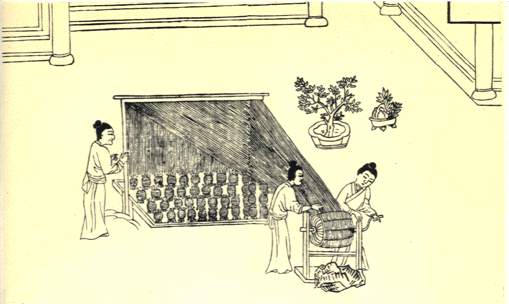
Abb.: Aufspulen der Seide
"Several filaments are combined to form a yarn. The operators in the filature must be careful to join the fibers so that the diameter of the reeled silk remains uniform in size. Uniformely reeled filament silk is the most valuable. As the fibers are combined and wrapped onto the reel, twist can be added to hold the filaments together. Adding twist is referred to as throwing and the resulting yarn is called a thrown yarn.
There are several types of thrown yarns. The type of yarn and amount of twist relate to the type of fabric desired. The simplest type of thrown yarn is a singles. In a singles, three to eight filaments are twistes together to form a yarn. Commmonly used for filling yarns in many silk fabrics, singles may have two or three twists per inch." [Kadolph-Langford, S. 62]
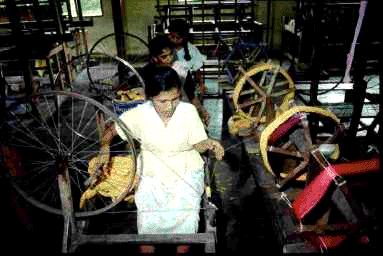
Abb.: Seidenspinnen, Ranaketugama, Sri Lanka, 1993 (Quelle: FAO)
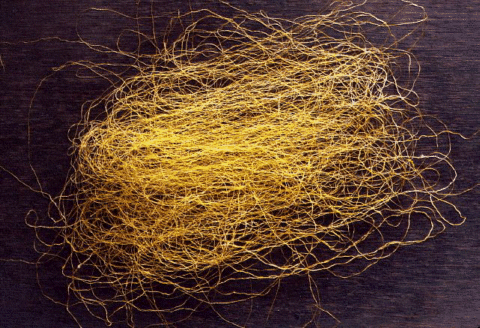
Abb.: Rohseidenfaden, Chiangmai, Thailand, 1995 (©Corbis)
"Much usable silk is not reeled because long filaments cannot be taken from a damaged cocoon. Coccoons in which the filament broke or the moth was allowed to mature and silk from the inner portions of the cocoon yield staple silk, often referred to as silk noils, or silk waste. This silk is degummed (the sericin is removed) and spun like any other staple fiber or blended with another staple fiber and spun into a yarn. Sun silk is less expensive, less durable, of lower quality than filament silk, and tends to pill. Wild silk production is not controlled as is production of cultivated silk. Although many species of wild silkworms produce wild silk, the two most common are Antheraea mylitta and Antheraea pernyi. The silkworms feed on oak and cherry leaves and produce fibers that are much less uniform in texture and color. The fiber may be brown, yellow, orange, or green, with brown the most common color. Current research is investigating the feasibility of producing fabrics of these naturally colored silks.
Since the cocoons are harvested after the moth has matured, the silk cannot be reeled and must be used as spun silk.
- Tussah silk is the most common type of wild silk. It is coarser, darker, and cannot be bleached. Hence, white and light colors are not available in tussah silk.
- Tasar is a type of wild silk from India. Some fabrics are sold simply as wild silk. "Raw silk" is sometimes used incorrectly to describe these fabrics.
Duppioni silk results when two silkworms spin their cocoons together. The yarn is irregular in diameter with a thick-thin appearance. It is used in linenlike silk fabrics like shantung." [Kadolph-Langford, S. 62f.]
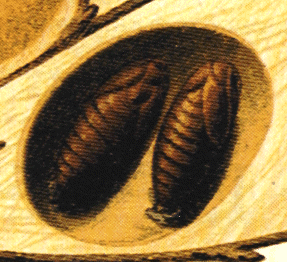
Abb.: Aufgeschnittener Doppelkokon [Quelle: Brockhaus, 1895]
"In filament form, silk does ot have good covering power. Before the development of strong synthetic fibers, silk was the only strong filament and silk fabrics were often treated with metallic salts such as tin, a process called weighting, to give the fabric better
- drape,
- covering power, and
- dye absorption.
Unfortunately, these historic weighted silks aged quickly." [Kadolph-Langford, S. 64]
Thailand: "The worms inside the cocoons provide a tasty snack for village children who stand and keep an eye open for the juiciest ones as they emerge from the cauldron. In poor villages silkworms provide an important source of protein for children and adults. To make a delicious dish the worms are ground to form a paste and mixed with chilli, garlic, salt and shallots, or they are roasted in banana leaves with herbs and spices. Any surplus worms are bartered in the village or sold in a local market." [Conway, S. 68] China: "The huge electric fans shoving hot air through Silk Factory # 1 in the city of Suzhou, near Shanghai, are quiet compared to the clattering din of the machines where a team of women are turning silkworm cocoons into thread. I talk to Tao Xiuzeng who has spent eighteen years in the factory pulling cocoons from the hot water bath that loosens the silk, stripping off the silk, and tossing the rest of the pupae into a bucket.
Occasionally she brings silkworm pupae home to eat. I wash them in water and bake them in the oven to dry, she tells us, then I fry them in oil with ginger, onion, rice wine, and garlic. The women working nearby agree that stir-frying is the best way to cook silkworm pupae.
Tao's immediate neighbor, working across from her in the factory line, tells us that eating silkworm pupae helps cure health problems like rheumatism. And they taste good, she says, contributing her laughter to the din. Tao's 8-year-old daughter refuses to eat silkworms. She's afraid of them, her perplexed mother says.
Li Jiangeng, who handles the finished silk thread in the next room, says she doesn't like to eat the silkworm pupae. After further discussion, she admits that she actually has never eaten them. Asked if she would ever eat a scorpion, a popular item in the south, her mouth drops open in amazement. I'm afraid of scorpions, she says. If I had to eat something, maybe the silkworm pupae would taste better."
[Menzel, Peter <1948 - > ; D'Aluisio, Faith <1957 - >: Man eating bugs : the art and science of eating insects. -- Berkeley, CA : Ten Speed Press, ©1998. -- (A material world book). -- ISBN 1580080227-- S. 90. -- ]
Neben der genannten Nutzung von gebrochenen Kokons für gesponnene Seide und von Puppen als menschliche Nahrung sind noch folgende Nutzungen der "Abfallprodukte" möglich:
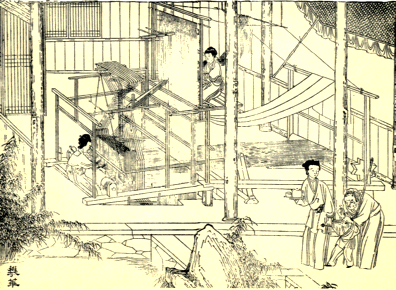
Abb.: Weben der Seide
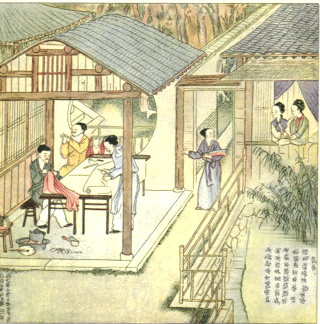 *
*
Abb.: Anfertigung der Kleider
"In einigen Gebieten Asiens, besonders in Korea, hat der Rizinusseidenspinner (Bombyx cynthia) wirtschaftliche Bedeutung. Der Rizinusseidenspinner entwickelt sich schneller als der Maulbeerseidenspinner und ist gegenüber Umwelteinflüssen widerstandsfähiger. Rizinusblätter bilden die Grundlage seiner Nahrung. Das Verfahren der Kokonproduktion ähnelt dem der Maulbeerseidenspinner. Die Raupen des Rizinusseidenspinners erhalten in den ersten Tagen bis zu 8mal am Tag fein zerkleinerte junge Blätter. Später können die Raupen größere Blätter oder Triebe in kürzeren Abständen erhalten. Die Umbettung und der Wechsel der Unterlagen geschehen ebenso wie beim Maulbeerseidenspinner. Sieben bis acht Tage nach Beginn des Einspinnens werden die Kokons vom Spinngerüst oder den Spinnzweigen genommen. Sie erfahren die gleiche Weiterbehandlung wie die Kokons der Maulbeerseidenspinner. [Es] unterscheiden sich die Bedingungen und die Durchführung der Aufzucht der Raupen des Rizinusseidenspinners nur geringfügig vom Aufzuchtverfahren des Maulbeerseidenspinners."
[Legel, Siegfried. -- In: Nutztiere der Tropen und Subtropen / Hrsg. Siegfried Legel. -- Stuttgart [u.a.] : Hirzel.. -- Bd. 3: Pferde/Esel, Schweine, Elefanten, Geflügel, Bienen, Seidenspinner. -- ©1993. -- ISBN 3777604976. -- S. 712]
Zu Kapitel 8,9: Seidenraupen, Teil III